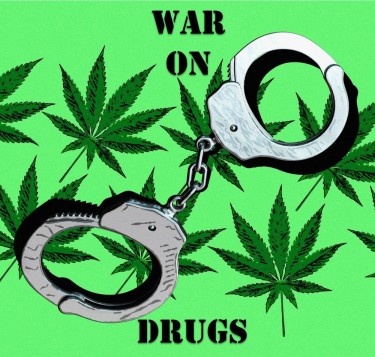
Is it time to repeal the Controlled Substance Act? (NIDA can now agree to you)
If the highest federal drug abuse agency complains about the evils of the ban – maybe it is time to ditch the entire experiment and say “Do over!”
Of course, NIDA did not support the idea of repealing the CSA but pointed out some serious problems with the policy that makes their job of testing the safety of medicines very difficult. While I am personally more inclined to repeal the Controlled Substance Act entirely for a variety of reasons; I can also understand that a change on this scale is very difficult.
This is especially true of the ignorance of the majority of people about drug use.
In this article, we’ll take a closer look at the National Institute on Drug Addiction’s report on List I Barriers to Research. We’ll also look at the broader topic of drug prohibition, social impact, and government supremacy.
However, let’s first take a look at NIDA’s position.
NIDA sends a report to Congress
An article in Marijuana Moment outlined a report NIDA sent to Congress discussing how the CSA and Schedule I drugs are preventing or preventing scientists from studying the potential risks and benefits of drugs.
Additionally, the current system prevents NIDA from using cannabis in the pharmacy, which means the research they have on cannabis is inconsistent with the current market standard. This is because there is only one sanctioned acreage in the US. The DEA said it would add to that list of sanctioned breeders – but at the time of this writing there was no movement.
If you examine the history of the DEA and its relationship to the actual understanding of the drugs they seek to enforce, you will see a similar pattern spanning decades.
Nevertheless, the report submitted by NIDA puts the DEA in a bad light. Here are some excerpts from the report;
“Researchers have reported that obtaining a new registration can take more than a year, that changing a registration can also be time-consuming and that different interpretations of the registration requirements according to Appendix I between local DEA branch offices, research institutions and various federal offices and state registration requirements, Complicate the process considerably … These challenges can hamper critical research on List I substances and deter scientists from pursuing such work. “
More importantly, the agency noticed;
“One overarching concern expressed by researchers is the lack of transparency regarding the registration requirements for List I and List II-V substances and the different interpretations of these requirements by DEA field agents and research organizations.”
In other words, that the arbitrary term of the Narcotics Act is not scientific and there is neither transparency in the registration process nor a uniform definition of these categories.
This is pretty devastating to a government that claims it allows “science” to dictate its decisions.
Below is a list of some of the issues that NIDA addressed in the report:
-
Schedule I can introduce “unexpected delays in ongoing research”.
-
Researchers who need to change course in a study on a List I substance – including what appears to be minor measures like adjusting the amount used – will have to re-register with the DEA, adding further delays.
-
Previously, only one person on a team of investigators had to be registered with the DEA. That has apparently changed over time as researchers tell NIDA that all members of the team need separate registrations.
-
DEA has in some instances required researchers to obtain multiple registrations for each physical location where they conduct studies on List I drugs, even if all research is on a single campus.
-
Complications in accessing various formulations and dosages of List I drugs have also proven difficult, creating confusion as to whether a separate and more expensive manufacturing registration is required for researchers whose studies require, for example, dissolving marijuana extracts in ethanol or oil can be used.
SOURCE: Marijuana Moment
This is only part of the equation.
As mentioned earlier, the DEA has claimed it wants more production of these federally illegal substances – researchers make an additional point.
The cannabis they are using for testing – even if more breeders are produced – would not be the same cannabis that is being sold in stores. This means that the information they would accumulate would not accurately reflect what the end user is using.
“Researchers supported by NIDA and other federal agencies are unable to use federal funds to purchase marijuana available through state marijuana dispensaries,” the agency said.
“In addition, some universities have expressed reluctance to allow investigators to buy pharmacy products with non-state funds or to conduct research with these products for university reasons for fear of violating federal law,” source: Marijuana Moment
Why go around the bush? Let’s get rid of the CSA!
The Controlled Substance Act is a document that stipulates that certain substances are “so dangerous” that using them would be a criminal offense. It creates arbitrary classifications for certain drugs that have no scientific validity.
In addition, the Narcotics Act directly violates the right of the individual to decide what to add to his body.
I know – some people think that’s a good thing. We don’t want heroin being shot everywhere, do we?
The problem with this assessment is that it is based on the premise that humanity has no control over its impulses. I often ask people who find my views “extreme” whether they would inject heroin tomorrow if it were legal.
The vast majority of people say a “hard no!” Of course, they wouldn’t smoke crack, consume meth, or inject heroin if it were legal. But others could … and that’s why we need these laws!
However, wherever heroin use has been legalized in safe rooms, heroin use has declined. More impressive is that the average age of heroin use has increased – meaning younger people are giving up heroin.
The CSA does not achieve its goal. It doesn’t keep drugs out of people’s hands. It doesn’t reduce the risk of teenagers getting their hands on it. It does not make the drugs any safer, nor does it make the users more knowledgeable about their use.
If we look at the CSA objectively, we can see that only a few groups of people benefit from it; Law enforcement, the prison industrial complex, big pharma, and the political class.
The Controlled Substance Act is the Slavers contract that Nixon drew up with the pharmaceutical industry in the 1970s.
Cancel the CSA – even NIDA agrees!
WHO IS THE NIDA, READ MORE …

HOW NIDA IS BLOCKING MARIJUANA RESEARCH AGAIN!
OR..

THE END OF THE DRUG WAR BEGINS WITH THE END OF THE CSA, READ THIS!

Post a comment: